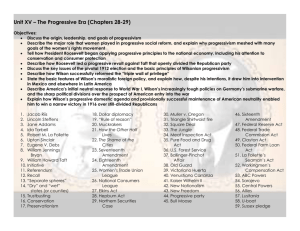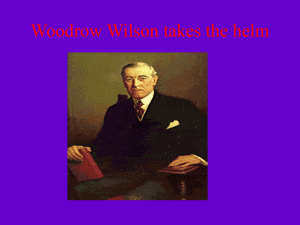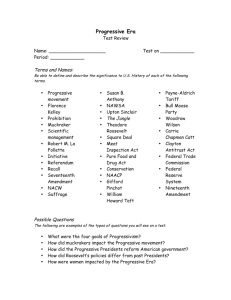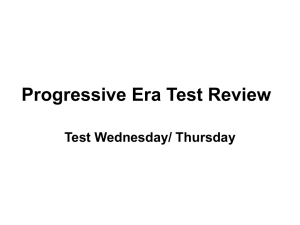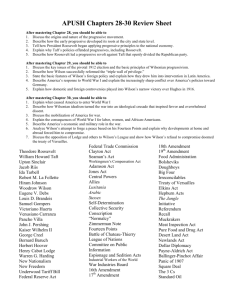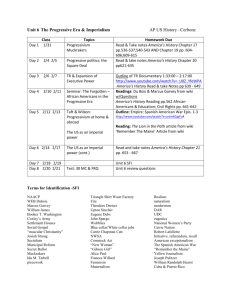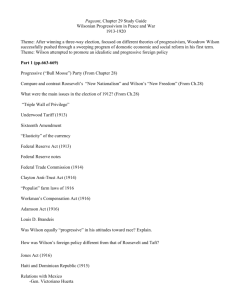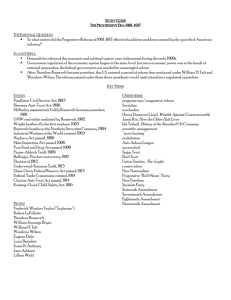AP U
advertisement
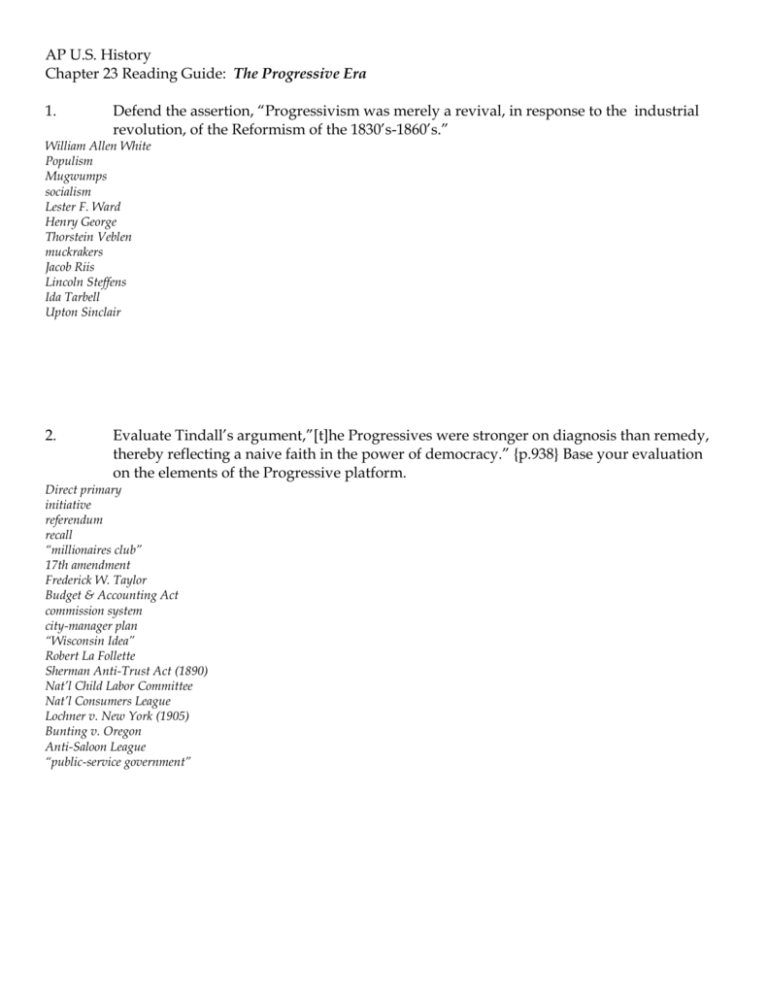
AP U.S. History
Chapter 23 Reading Guide: The Progressive Era
1.
Defend the assertion, “Progressivism was merely a revival, in response to the industrial
revolution, of the Reformism of the 1830’s-1860’s.”
William Allen White
Populism
Mugwumps
socialism
Lester F. Ward
Henry George
Thorstein Veblen
muckrakers
Jacob Riis
Lincoln Steffens
Ida Tarbell
Upton Sinclair
2.
Evaluate Tindall’s argument,”[t]he Progressives were stronger on diagnosis than remedy,
thereby reflecting a naive faith in the power of democracy.” {p.938} Base your evaluation
on the elements of the Progressive platform.
Direct primary
initiative
referendum
recall
“millionaires club”
17th amendment
Frederick W. Taylor
Budget & Accounting Act
commission system
city-manager plan
“Wisconsin Idea”
Robert La Follette
Sherman Anti-Trust Act (1890)
Nat’l Child Labor Committee
Nat’l Consumers League
Lochner v. New York (1905)
Bunting v. Oregon
Anti-Saloon League
“public-service government”
3.
Analyze Theodore Roosevelt’s “Square Deal.” How consonant was it with the Progressive
program? In what ways is it a mistake to see TR as a true “progressive?”
Mark Hanna
Joe Cannon
Northern Securities Case
George F. Baer
United Mine Workers
Swift & Co. v. U.S. (1905)
Expedition Act
Elkins Act
Bureau of Corporations
Hepburn Act
Meat Inspection Act
Pure Food and Drug Act
Gifford Pinchot
National Conservation
Commission
4.
How valid is the contention, “Taft was the real ‘trust buster’ not TR!.” Does this mean Taft
was truly the Progressive Republican President?
Dollar Diplomacy
Aldrich Tariff
assistant democrats
Ballinger-Pinchot Affair
United States Steel v. U.S.
Appalachian Forest Reserve
Act (1911)
Mann-Elkins Act
Postal Savings Law
Bureau of Mines
Federal Children’s Bureau
Sixteenth Amendment
Seventeenth Amendment
5.
Compare Roosevelt’s “New Nationalism” of the Bull Moose Party with his earlier “Square
Deal” as President. Why does he seem more progressive as a political outsider than as
leader of the dominant national political party of the time?
6.
Contrast Wilson’s platform of “New Freedom” with Roosevelt’s “New Nationalism.” What
essential focus do both share?
Herbert Croly
Louis Brandeis
“Hamiltonian means/
Jeffersonian Ends”
7.
Why was the Presidential Election of 1912 a watershed in american political life?
Champ Clark
William Jennings Bryan
William Howard Taft
Col. Edward M. House
Bull Moose Progressives
8.
Compare Wilson’s first progressive program [1913] with his second [c.1916]. Why is the
second phase more radical in character? What does Wilson’s first term as president reveal
about his commitment to progressive reform?
Underwood-Simmons Tariff
16th Amendment
Federal Reserve System
Federal Trade Commission
Clayton Antitrust Act (1914)
La Follette Seaman’s Act (1915)
Federal Farm Loan Act (1916)
Warehouse Act (1916)
Smith-Lever Act (1914)
Smith-Hughes Act (1917)
Federal Highways Act (1916)
Kern-McGillicuddy Bill (1916)
Keating-Owen Child Labor Act
Adamson Act (1916)
9.
Why did Progressivism reach its zenith during Wilson’s first term? As a democratic
movement why did it’s support fade so rapidly?
